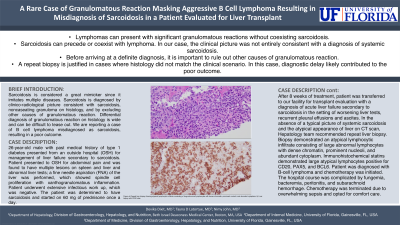Tuesday Poster Session
Category: Liver
P4784 - A Rare Case of Granulomatous Reaction Masking Aggressive B Cell Lymphoma Resulting in Misdiagnosis of Sarcoidosis in a Patient Evaluated for Liver Transplant
Tuesday, October 29, 2024
10:30 AM - 4:00 PM ET
Location: Exhibit Hall E

Has Audio

Devika Dixit, MD
University of Florida College of Medicine
Gainesville, FL
Presenting Author(s)
Devika Dixit, MD1, Tayna Latortue, MD1, Juhi D. Mahadik, MD1, Virginia Clark, MD, MS1, Nimy John, MD2
1University of Florida College of Medicine, Gainesville, FL; 2University of Florida College of Medicine, Newberry, FL
Introduction: Sarcoidosis is considered a great mimicker since it imitates multiple diseases. Sarcoidosis is diagnosed by clinico-radiological picture consistent with sarcoidosis, noncaseating granuloma on histology, and by excluding other causes of granulomatous reaction. Differential diagnosis of granulomatous reaction on histology is wide and can be difficult to tease out. We are reporting a case of B cell lymphoma misdiagnosed as sarcoidosis, resulting in a poor outcome.
Case Description/Methods: 26-year-old male with past medical history of type 1 diabetes presented from an outside hospital (OSH) for management of liver failure secondary to sarcoidosis. Patient presented to OSH for abdominal pain and was found to have multiple lesions on spleen and liver and abnormal liver tests; a fine needle aspiration (FNA) of the liver was performed, which showed spindle cell proliferation with xanthogranulomatous inflammation. Patient underwent extensive infectious work up, which was negative. The patient was determined to have sarcoidosis and started on 60 mg of prednisone once a day.
After 8 weeks of treatment, patient was transferred to our facility for transplant evaluation with a diagnosis of acute liver failure secondary to sarcoidosis in the setting of worsening liver tests, recurrent pleural effusions and ascites. In the absence of a typical picture of systemic sarcoidosis and the atypical appearance of liver on CT scan, Hepatology team recommended repeat liver biopsy. Biopsy demonstrated an atypical lymphocytic infiltrate consisting of large abnormal lymphocytes with dense chromatin, prominent nucleoli, and abundant cytoplasm. Immunohistochemical statins demonstrated large atypical lymphocytes positive for CD20, PAX5, and BCL6. Patient was diagnosed with B-cell lymphoma
and chemotherapy was initiated. The hospital course was complicated by fungemia, bacteremia, peritonitis, and subarachnoid hemorrhage. Chemotherapy was terminated due to overwhelming sepsis and opted for comfort care.
Discussion: Lymphomas can present with significant granulomatous reactions without coexisting sarcoidosis. Sarcoidosis can precede or coexist with lymphoma. In our case, the clinical picture was not entirely consistent with a diagnosis of systemic sarcoidosis. Before arriving at a definite diagnosis, it is important to rule out other causes of granulomatous reaction. A repeat biopsy is justified in cases where histology did not match the clinical scenario. In this case, diagnostic delay likely contributed to the poor outcome.

Disclosures:
Devika Dixit, MD1, Tayna Latortue, MD1, Juhi D. Mahadik, MD1, Virginia Clark, MD, MS1, Nimy John, MD2. P4784 - A Rare Case of Granulomatous Reaction Masking Aggressive B Cell Lymphoma Resulting in Misdiagnosis of Sarcoidosis in a Patient Evaluated for Liver Transplant, ACG 2024 Annual Scientific Meeting Abstracts. Philadelphia, PA: American College of Gastroenterology.
1University of Florida College of Medicine, Gainesville, FL; 2University of Florida College of Medicine, Newberry, FL
Introduction: Sarcoidosis is considered a great mimicker since it imitates multiple diseases. Sarcoidosis is diagnosed by clinico-radiological picture consistent with sarcoidosis, noncaseating granuloma on histology, and by excluding other causes of granulomatous reaction. Differential diagnosis of granulomatous reaction on histology is wide and can be difficult to tease out. We are reporting a case of B cell lymphoma misdiagnosed as sarcoidosis, resulting in a poor outcome.
Case Description/Methods: 26-year-old male with past medical history of type 1 diabetes presented from an outside hospital (OSH) for management of liver failure secondary to sarcoidosis. Patient presented to OSH for abdominal pain and was found to have multiple lesions on spleen and liver and abnormal liver tests; a fine needle aspiration (FNA) of the liver was performed, which showed spindle cell proliferation with xanthogranulomatous inflammation. Patient underwent extensive infectious work up, which was negative. The patient was determined to have sarcoidosis and started on 60 mg of prednisone once a day.
After 8 weeks of treatment, patient was transferred to our facility for transplant evaluation with a diagnosis of acute liver failure secondary to sarcoidosis in the setting of worsening liver tests, recurrent pleural effusions and ascites. In the absence of a typical picture of systemic sarcoidosis and the atypical appearance of liver on CT scan, Hepatology team recommended repeat liver biopsy. Biopsy demonstrated an atypical lymphocytic infiltrate consisting of large abnormal lymphocytes with dense chromatin, prominent nucleoli, and abundant cytoplasm. Immunohistochemical statins demonstrated large atypical lymphocytes positive for CD20, PAX5, and BCL6. Patient was diagnosed with B-cell lymphoma
and chemotherapy was initiated. The hospital course was complicated by fungemia, bacteremia, peritonitis, and subarachnoid hemorrhage. Chemotherapy was terminated due to overwhelming sepsis and opted for comfort care.
Discussion: Lymphomas can present with significant granulomatous reactions without coexisting sarcoidosis. Sarcoidosis can precede or coexist with lymphoma. In our case, the clinical picture was not entirely consistent with a diagnosis of systemic sarcoidosis. Before arriving at a definite diagnosis, it is important to rule out other causes of granulomatous reaction. A repeat biopsy is justified in cases where histology did not match the clinical scenario. In this case, diagnostic delay likely contributed to the poor outcome.

Figure: Figure a) Repeat liver biopsy showing atypical lymphocytic infiltrate consisting of large abnormal lymphocytes with dense chromatin, prominent nucleoli, and abundant cytoplasm. b) Liver biopsy with CD20 stain
Disclosures:
Devika Dixit indicated no relevant financial relationships.
Tayna Latortue indicated no relevant financial relationships.
Juhi Mahadik indicated no relevant financial relationships.
Virginia Clark: hamni pharmaceuticals – Grant/Research Support. Takeda Pharmaceuticals – Consultant, Grant/Research Support. Vertex – Grant/Research Support.
Nimy John indicated no relevant financial relationships.
Devika Dixit, MD1, Tayna Latortue, MD1, Juhi D. Mahadik, MD1, Virginia Clark, MD, MS1, Nimy John, MD2. P4784 - A Rare Case of Granulomatous Reaction Masking Aggressive B Cell Lymphoma Resulting in Misdiagnosis of Sarcoidosis in a Patient Evaluated for Liver Transplant, ACG 2024 Annual Scientific Meeting Abstracts. Philadelphia, PA: American College of Gastroenterology.
